Contemporary Social Work: Teenage Mothers, Attachment, and Practice
VerifiedAdded on 2022/11/10
|18
|4315
|272
Essay
AI Summary
This essay delves into the challenges faced by teenage mothers and their infants, analyzing the application of attachment theory and anti-oppressive practice within a social work context. It examines the common issues experienced by young mothers, often at the intersection of marginalized categories, and explores the strengths and limitations of each theoretical framework. The paper connects these theories to modernism and critical theory, evaluating their efficacy in addressing the specific needs of this cohort. It also discusses the ethical role of the practitioner in promoting social justice and regulations. The essay uses statistical data and research to support its claims, providing a comprehensive overview of contemporary teenage parenting in Australia and concludes with a summary of findings and reflections on social work values.

Tjunkaya Ken ID: 110205144 Case Study WELF 3007
Contemporary practices in social work
By Tjunkaya Ken
Institutional affiliating
1
Contemporary practices in social work
By Tjunkaya Ken
Institutional affiliating
1
Paraphrase This Document
Need a fresh take? Get an instant paraphrase of this document with our AI Paraphraser
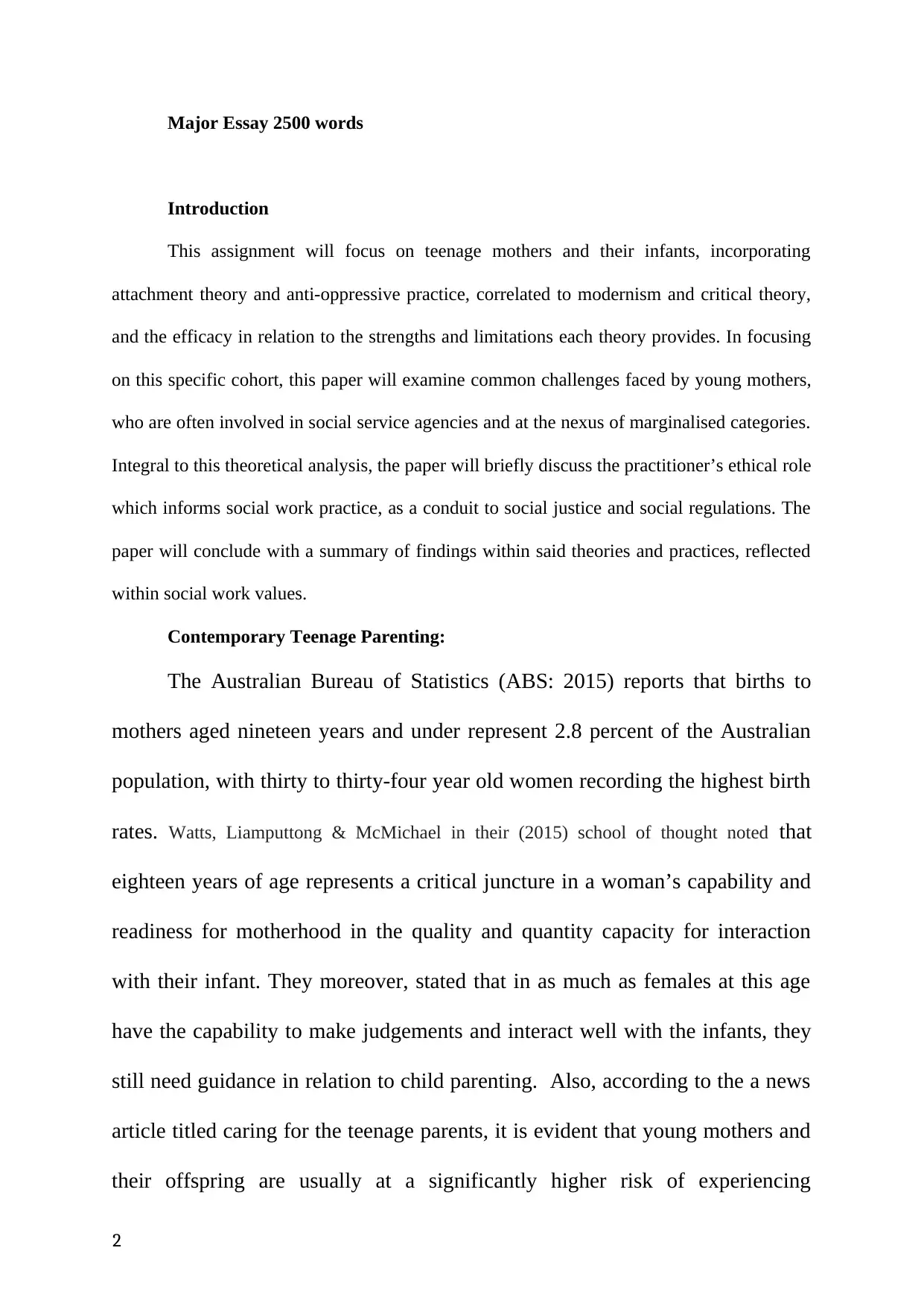
Major Essay 2500 words
Introduction
This assignment will focus on teenage mothers and their infants, incorporating
attachment theory and anti-oppressive practice, correlated to modernism and critical theory,
and the efficacy in relation to the strengths and limitations each theory provides. In focusing
on this specific cohort, this paper will examine common challenges faced by young mothers,
who are often involved in social service agencies and at the nexus of marginalised categories.
Integral to this theoretical analysis, the paper will briefly discuss the practitioner’s ethical role
which informs social work practice, as a conduit to social justice and social regulations. The
paper will conclude with a summary of findings within said theories and practices, reflected
within social work values.
Contemporary Teenage Parenting:
The Australian Bureau of Statistics (ABS: 2015) reports that births to
mothers aged nineteen years and under represent 2.8 percent of the Australian
population, with thirty to thirty-four year old women recording the highest birth
rates. Watts, Liamputtong & McMichael in their (2015) school of thought noted that
eighteen years of age represents a critical juncture in a woman’s capability and
readiness for motherhood in the quality and quantity capacity for interaction
with their infant. They moreover, stated that in as much as females at this age
have the capability to make judgements and interact well with the infants, they
still need guidance in relation to child parenting. Also, according to the a news
article titled caring for the teenage parents, it is evident that young mothers and
their offspring are usually at a significantly higher risk of experiencing
2
Introduction
This assignment will focus on teenage mothers and their infants, incorporating
attachment theory and anti-oppressive practice, correlated to modernism and critical theory,
and the efficacy in relation to the strengths and limitations each theory provides. In focusing
on this specific cohort, this paper will examine common challenges faced by young mothers,
who are often involved in social service agencies and at the nexus of marginalised categories.
Integral to this theoretical analysis, the paper will briefly discuss the practitioner’s ethical role
which informs social work practice, as a conduit to social justice and social regulations. The
paper will conclude with a summary of findings within said theories and practices, reflected
within social work values.
Contemporary Teenage Parenting:
The Australian Bureau of Statistics (ABS: 2015) reports that births to
mothers aged nineteen years and under represent 2.8 percent of the Australian
population, with thirty to thirty-four year old women recording the highest birth
rates. Watts, Liamputtong & McMichael in their (2015) school of thought noted that
eighteen years of age represents a critical juncture in a woman’s capability and
readiness for motherhood in the quality and quantity capacity for interaction
with their infant. They moreover, stated that in as much as females at this age
have the capability to make judgements and interact well with the infants, they
still need guidance in relation to child parenting. Also, according to the a news
article titled caring for the teenage parents, it is evident that young mothers and
their offspring are usually at a significantly higher risk of experiencing
2
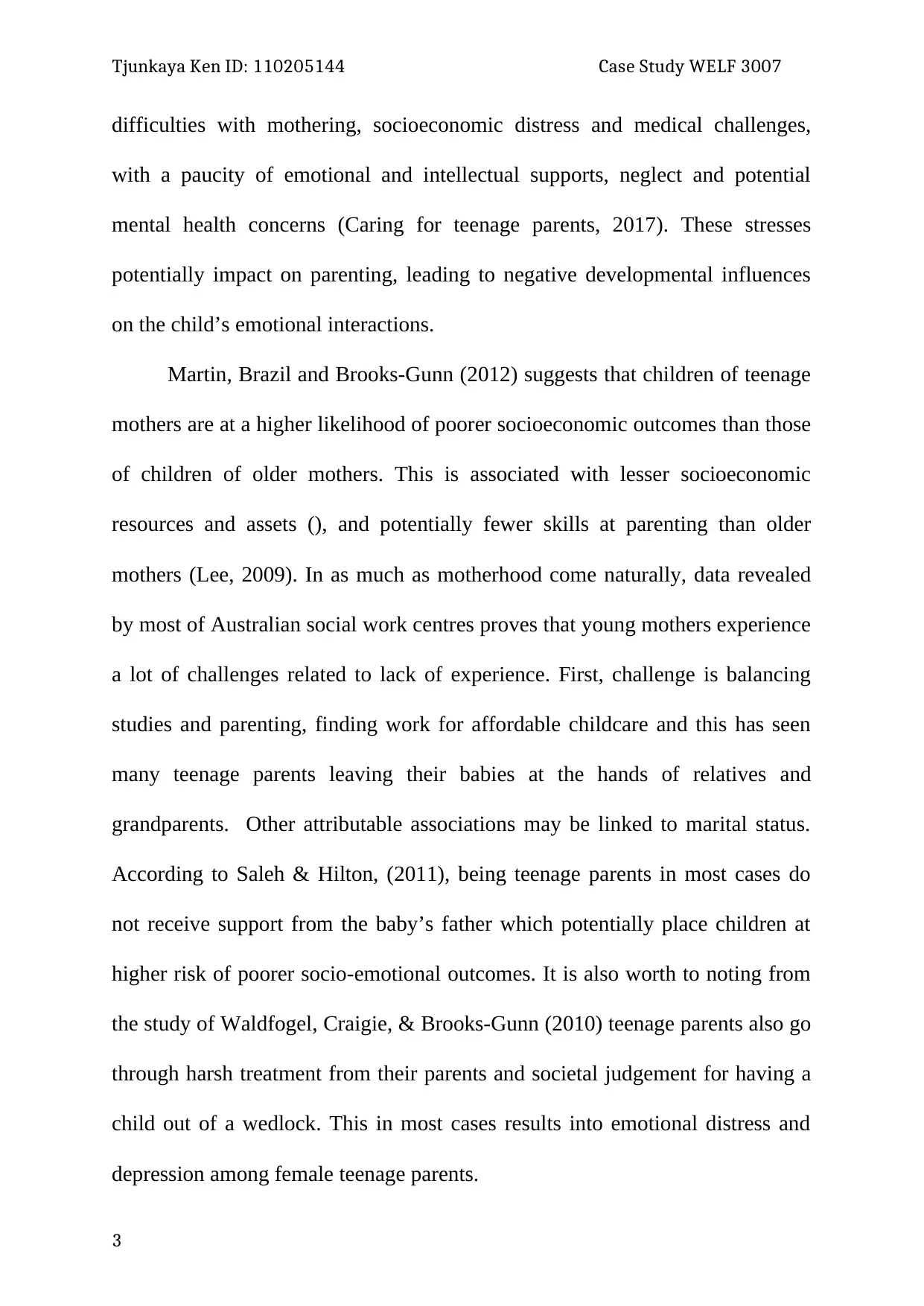
Tjunkaya Ken ID: 110205144 Case Study WELF 3007
difficulties with mothering, socioeconomic distress and medical challenges,
with a paucity of emotional and intellectual supports, neglect and potential
mental health concerns (Caring for teenage parents, 2017). These stresses
potentially impact on parenting, leading to negative developmental influences
on the child’s emotional interactions.
Martin, Brazil and Brooks-Gunn (2012) suggests that children of teenage
mothers are at a higher likelihood of poorer socioeconomic outcomes than those
of children of older mothers. This is associated with lesser socioeconomic
resources and assets (), and potentially fewer skills at parenting than older
mothers (Lee, 2009). In as much as motherhood come naturally, data revealed
by most of Australian social work centres proves that young mothers experience
a lot of challenges related to lack of experience. First, challenge is balancing
studies and parenting, finding work for affordable childcare and this has seen
many teenage parents leaving their babies at the hands of relatives and
grandparents. Other attributable associations may be linked to marital status.
According to Saleh & Hilton, (2011), being teenage parents in most cases do
not receive support from the baby’s father which potentially place children at
higher risk of poorer socio-emotional outcomes. It is also worth to noting from
the study of Waldfogel, Craigie, & Brooks-Gunn (2010) teenage parents also go
through harsh treatment from their parents and societal judgement for having a
child out of a wedlock. This in most cases results into emotional distress and
depression among female teenage parents.
3
difficulties with mothering, socioeconomic distress and medical challenges,
with a paucity of emotional and intellectual supports, neglect and potential
mental health concerns (Caring for teenage parents, 2017). These stresses
potentially impact on parenting, leading to negative developmental influences
on the child’s emotional interactions.
Martin, Brazil and Brooks-Gunn (2012) suggests that children of teenage
mothers are at a higher likelihood of poorer socioeconomic outcomes than those
of children of older mothers. This is associated with lesser socioeconomic
resources and assets (), and potentially fewer skills at parenting than older
mothers (Lee, 2009). In as much as motherhood come naturally, data revealed
by most of Australian social work centres proves that young mothers experience
a lot of challenges related to lack of experience. First, challenge is balancing
studies and parenting, finding work for affordable childcare and this has seen
many teenage parents leaving their babies at the hands of relatives and
grandparents. Other attributable associations may be linked to marital status.
According to Saleh & Hilton, (2011), being teenage parents in most cases do
not receive support from the baby’s father which potentially place children at
higher risk of poorer socio-emotional outcomes. It is also worth to noting from
the study of Waldfogel, Craigie, & Brooks-Gunn (2010) teenage parents also go
through harsh treatment from their parents and societal judgement for having a
child out of a wedlock. This in most cases results into emotional distress and
depression among female teenage parents.
3
⊘ This is a preview!⊘
Do you want full access?
Subscribe today to unlock all pages.

Trusted by 1+ million students worldwide
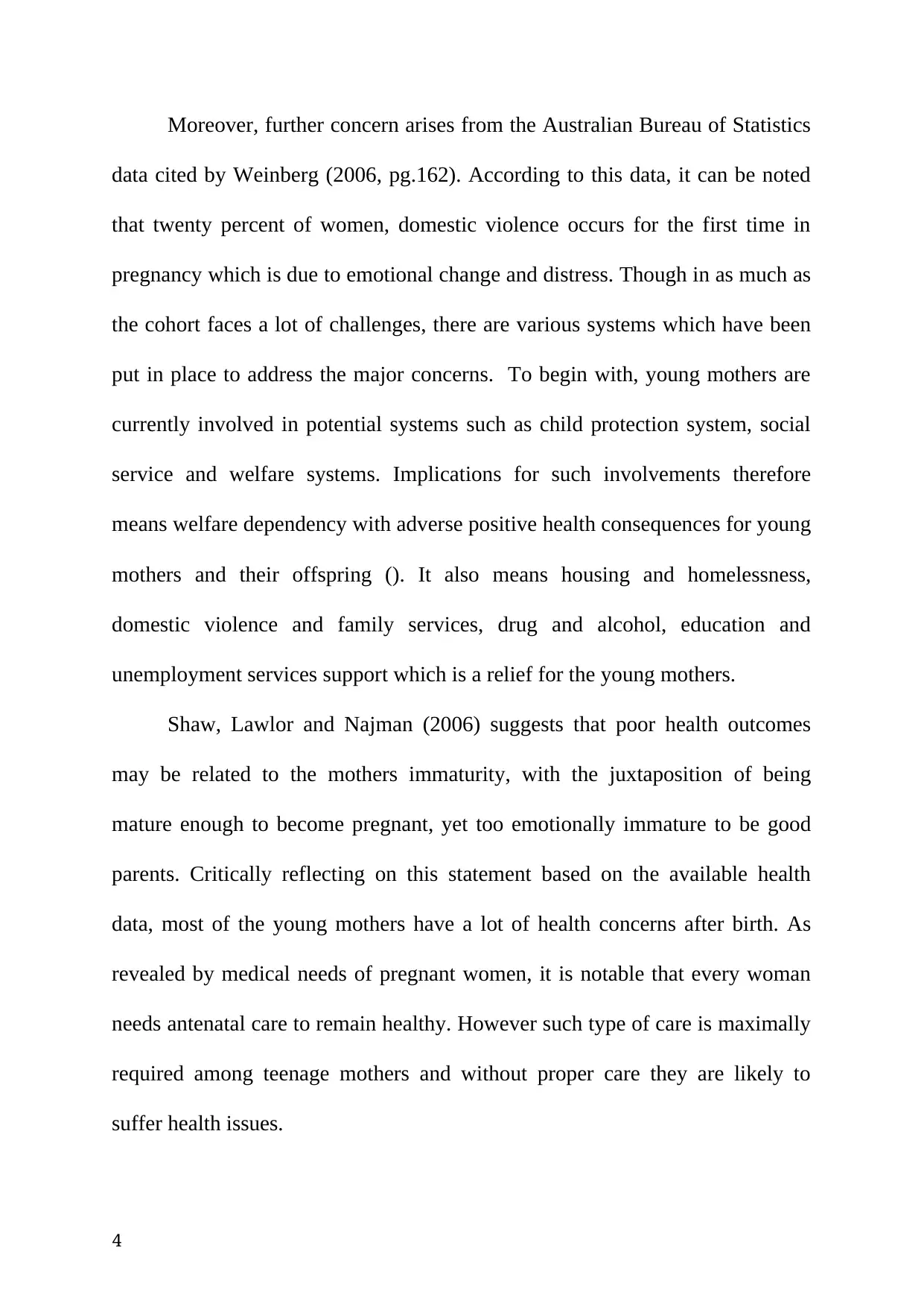
Moreover, further concern arises from the Australian Bureau of Statistics
data cited by Weinberg (2006, pg.162). According to this data, it can be noted
that twenty percent of women, domestic violence occurs for the first time in
pregnancy which is due to emotional change and distress. Though in as much as
the cohort faces a lot of challenges, there are various systems which have been
put in place to address the major concerns. To begin with, young mothers are
currently involved in potential systems such as child protection system, social
service and welfare systems. Implications for such involvements therefore
means welfare dependency with adverse positive health consequences for young
mothers and their offspring (). It also means housing and homelessness,
domestic violence and family services, drug and alcohol, education and
unemployment services support which is a relief for the young mothers.
Shaw, Lawlor and Najman (2006) suggests that poor health outcomes
may be related to the mothers immaturity, with the juxtaposition of being
mature enough to become pregnant, yet too emotionally immature to be good
parents. Critically reflecting on this statement based on the available health
data, most of the young mothers have a lot of health concerns after birth. As
revealed by medical needs of pregnant women, it is notable that every woman
needs antenatal care to remain healthy. However such type of care is maximally
required among teenage mothers and without proper care they are likely to
suffer health issues.
4
data cited by Weinberg (2006, pg.162). According to this data, it can be noted
that twenty percent of women, domestic violence occurs for the first time in
pregnancy which is due to emotional change and distress. Though in as much as
the cohort faces a lot of challenges, there are various systems which have been
put in place to address the major concerns. To begin with, young mothers are
currently involved in potential systems such as child protection system, social
service and welfare systems. Implications for such involvements therefore
means welfare dependency with adverse positive health consequences for young
mothers and their offspring (). It also means housing and homelessness,
domestic violence and family services, drug and alcohol, education and
unemployment services support which is a relief for the young mothers.
Shaw, Lawlor and Najman (2006) suggests that poor health outcomes
may be related to the mothers immaturity, with the juxtaposition of being
mature enough to become pregnant, yet too emotionally immature to be good
parents. Critically reflecting on this statement based on the available health
data, most of the young mothers have a lot of health concerns after birth. As
revealed by medical needs of pregnant women, it is notable that every woman
needs antenatal care to remain healthy. However such type of care is maximally
required among teenage mothers and without proper care they are likely to
suffer health issues.
4
Paraphrase This Document
Need a fresh take? Get an instant paraphrase of this document with our AI Paraphraser
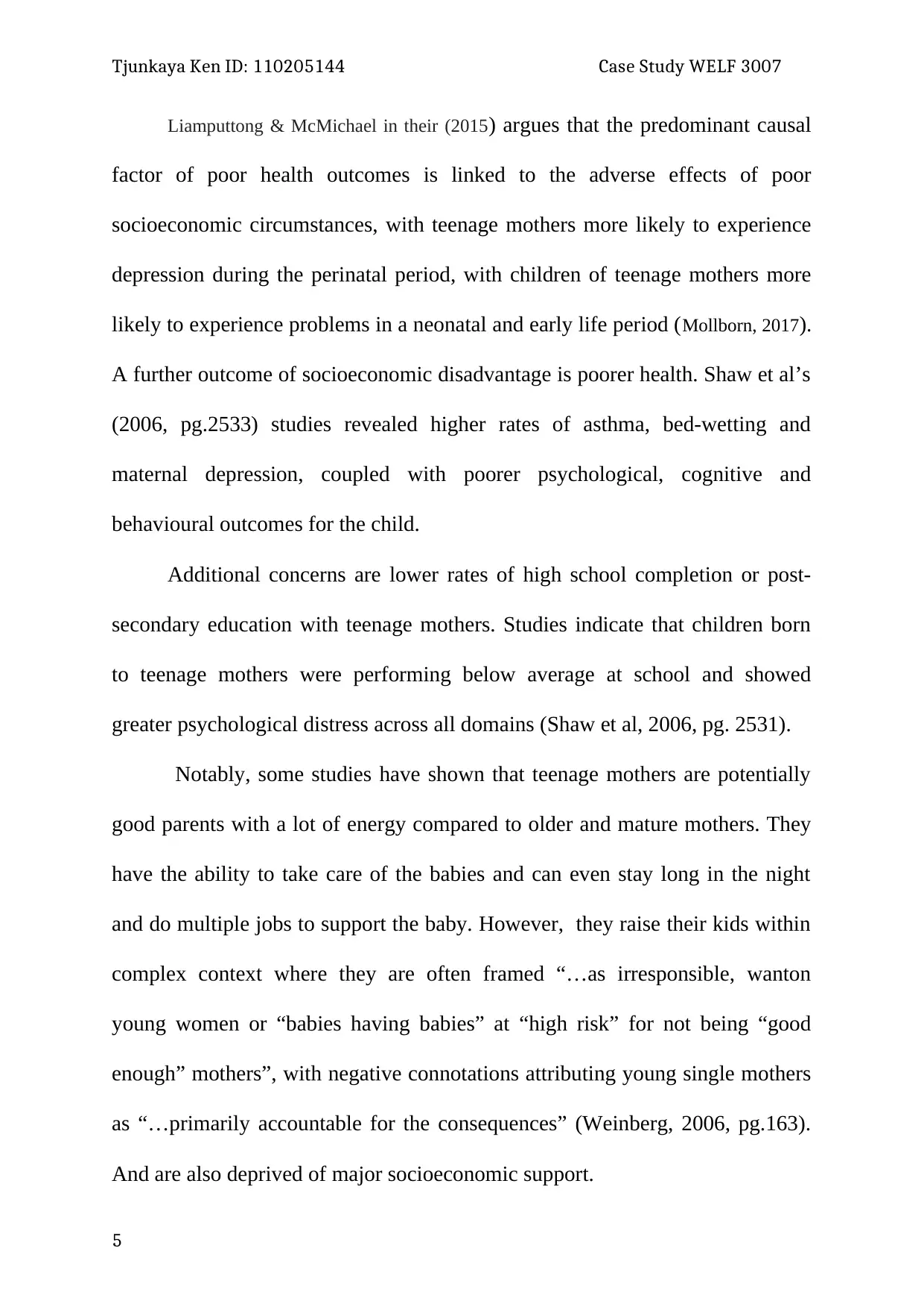
Tjunkaya Ken ID: 110205144 Case Study WELF 3007
Liamputtong & McMichael in their (2015) argues that the predominant causal
factor of poor health outcomes is linked to the adverse effects of poor
socioeconomic circumstances, with teenage mothers more likely to experience
depression during the perinatal period, with children of teenage mothers more
likely to experience problems in a neonatal and early life period (Mollborn, 2017).
A further outcome of socioeconomic disadvantage is poorer health. Shaw et al’s
(2006, pg.2533) studies revealed higher rates of asthma, bed-wetting and
maternal depression, coupled with poorer psychological, cognitive and
behavioural outcomes for the child.
Additional concerns are lower rates of high school completion or post-
secondary education with teenage mothers. Studies indicate that children born
to teenage mothers were performing below average at school and showed
greater psychological distress across all domains (Shaw et al, 2006, pg. 2531).
Notably, some studies have shown that teenage mothers are potentially
good parents with a lot of energy compared to older and mature mothers. They
have the ability to take care of the babies and can even stay long in the night
and do multiple jobs to support the baby. However, they raise their kids within
complex context where they are often framed “…as irresponsible, wanton
young women or “babies having babies” at “high risk” for not being “good
enough” mothers”, with negative connotations attributing young single mothers
as “…primarily accountable for the consequences” (Weinberg, 2006, pg.163).
And are also deprived of major socioeconomic support.
5
Liamputtong & McMichael in their (2015) argues that the predominant causal
factor of poor health outcomes is linked to the adverse effects of poor
socioeconomic circumstances, with teenage mothers more likely to experience
depression during the perinatal period, with children of teenage mothers more
likely to experience problems in a neonatal and early life period (Mollborn, 2017).
A further outcome of socioeconomic disadvantage is poorer health. Shaw et al’s
(2006, pg.2533) studies revealed higher rates of asthma, bed-wetting and
maternal depression, coupled with poorer psychological, cognitive and
behavioural outcomes for the child.
Additional concerns are lower rates of high school completion or post-
secondary education with teenage mothers. Studies indicate that children born
to teenage mothers were performing below average at school and showed
greater psychological distress across all domains (Shaw et al, 2006, pg. 2531).
Notably, some studies have shown that teenage mothers are potentially
good parents with a lot of energy compared to older and mature mothers. They
have the ability to take care of the babies and can even stay long in the night
and do multiple jobs to support the baby. However, they raise their kids within
complex context where they are often framed “…as irresponsible, wanton
young women or “babies having babies” at “high risk” for not being “good
enough” mothers”, with negative connotations attributing young single mothers
as “…primarily accountable for the consequences” (Weinberg, 2006, pg.163).
And are also deprived of major socioeconomic support.
5
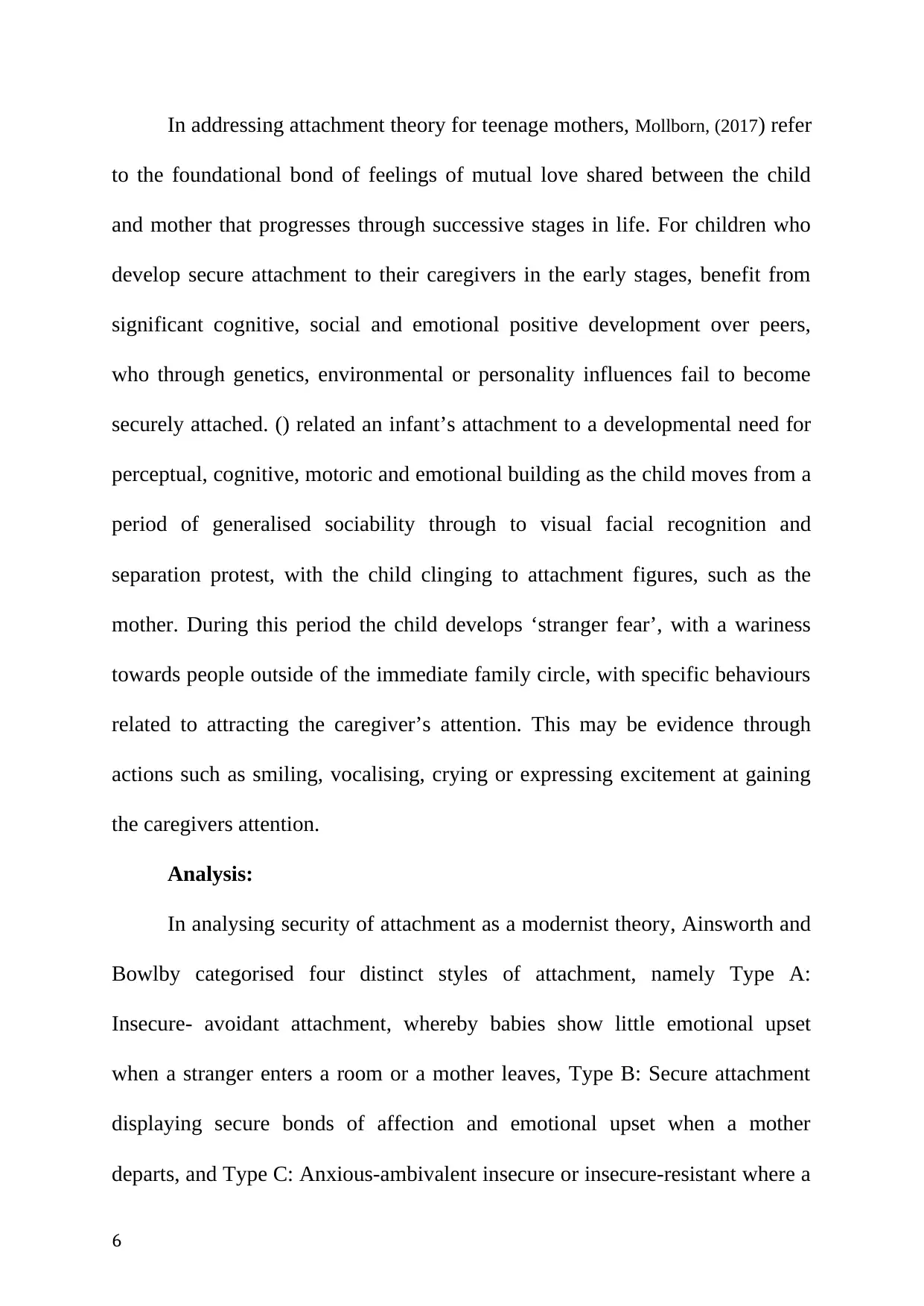
In addressing attachment theory for teenage mothers, Mollborn, (2017) refer
to the foundational bond of feelings of mutual love shared between the child
and mother that progresses through successive stages in life. For children who
develop secure attachment to their caregivers in the early stages, benefit from
significant cognitive, social and emotional positive development over peers,
who through genetics, environmental or personality influences fail to become
securely attached. () related an infant’s attachment to a developmental need for
perceptual, cognitive, motoric and emotional building as the child moves from a
period of generalised sociability through to visual facial recognition and
separation protest, with the child clinging to attachment figures, such as the
mother. During this period the child develops ‘stranger fear’, with a wariness
towards people outside of the immediate family circle, with specific behaviours
related to attracting the caregiver’s attention. This may be evidence through
actions such as smiling, vocalising, crying or expressing excitement at gaining
the caregivers attention.
Analysis:
In analysing security of attachment as a modernist theory, Ainsworth and
Bowlby categorised four distinct styles of attachment, namely Type A:
Insecure- avoidant attachment, whereby babies show little emotional upset
when a stranger enters a room or a mother leaves, Type B: Secure attachment
displaying secure bonds of affection and emotional upset when a mother
departs, and Type C: Anxious-ambivalent insecure or insecure-resistant where a
6
to the foundational bond of feelings of mutual love shared between the child
and mother that progresses through successive stages in life. For children who
develop secure attachment to their caregivers in the early stages, benefit from
significant cognitive, social and emotional positive development over peers,
who through genetics, environmental or personality influences fail to become
securely attached. () related an infant’s attachment to a developmental need for
perceptual, cognitive, motoric and emotional building as the child moves from a
period of generalised sociability through to visual facial recognition and
separation protest, with the child clinging to attachment figures, such as the
mother. During this period the child develops ‘stranger fear’, with a wariness
towards people outside of the immediate family circle, with specific behaviours
related to attracting the caregiver’s attention. This may be evidence through
actions such as smiling, vocalising, crying or expressing excitement at gaining
the caregivers attention.
Analysis:
In analysing security of attachment as a modernist theory, Ainsworth and
Bowlby categorised four distinct styles of attachment, namely Type A:
Insecure- avoidant attachment, whereby babies show little emotional upset
when a stranger enters a room or a mother leaves, Type B: Secure attachment
displaying secure bonds of affection and emotional upset when a mother
departs, and Type C: Anxious-ambivalent insecure or insecure-resistant where a
6
⊘ This is a preview!⊘
Do you want full access?
Subscribe today to unlock all pages.

Trusted by 1+ million students worldwide

Tjunkaya Ken ID: 110205144 Case Study WELF 3007
baby will exhibit clinging behaviour and distress when the mother leaves. Type
D: Insecure-disorganised as identified by Bennett, Alliex & Bulsara (2019), whereby
a baby displays “simultaneous contradictory behaviour” (Hardy & Prior, 2000).
Anti-oppressive practice, with a foundational basis to “…enhance
people’s wellbeing and uphold the values of human rights and social justice”
(Gray, Midgley & Webb, 2012, pg. 2), by addressing social divisions and
fundamental inequalities within communities. It encompasses a “…person-
centred philosophy with an egalitarian value system” focusing on structural
inequalities. This practice is directed towards a process and outcome, and works
to empower associations between individuals to counteract oppressive practice
(Gray et al, 2012, pg.5). Therefore, with implementation anti-oppressive
practice, the society will develop a culture of support and love towards young
mothers rather than viewing them as individuals with no future. Such a practice
will also create opportunities and a system which offer support teenage parents.
In a critical analysis of attachment theory for teenage mothers, Wade, Cann
& Matthews, (2019).) suggests that young mothers and their children are at a
greater risk for experiencing “…mothering disorders, socioeconomic and
medical problems, emotional and intellectual depravation, neglect, and
depression”. Evidence from previous studies suggests an existing correlation
between deprived childcare and the child’s normal development into adult life.
Empirical studies such as the study of Liamputtong & McMichael in their (2015)
indicate that teenage mothers have reduced levels of maternal interaction and
7
baby will exhibit clinging behaviour and distress when the mother leaves. Type
D: Insecure-disorganised as identified by Bennett, Alliex & Bulsara (2019), whereby
a baby displays “simultaneous contradictory behaviour” (Hardy & Prior, 2000).
Anti-oppressive practice, with a foundational basis to “…enhance
people’s wellbeing and uphold the values of human rights and social justice”
(Gray, Midgley & Webb, 2012, pg. 2), by addressing social divisions and
fundamental inequalities within communities. It encompasses a “…person-
centred philosophy with an egalitarian value system” focusing on structural
inequalities. This practice is directed towards a process and outcome, and works
to empower associations between individuals to counteract oppressive practice
(Gray et al, 2012, pg.5). Therefore, with implementation anti-oppressive
practice, the society will develop a culture of support and love towards young
mothers rather than viewing them as individuals with no future. Such a practice
will also create opportunities and a system which offer support teenage parents.
In a critical analysis of attachment theory for teenage mothers, Wade, Cann
& Matthews, (2019).) suggests that young mothers and their children are at a
greater risk for experiencing “…mothering disorders, socioeconomic and
medical problems, emotional and intellectual depravation, neglect, and
depression”. Evidence from previous studies suggests an existing correlation
between deprived childcare and the child’s normal development into adult life.
Empirical studies such as the study of Liamputtong & McMichael in their (2015)
indicate that teenage mothers have reduced levels of maternal interaction and
7
Paraphrase This Document
Need a fresh take? Get an instant paraphrase of this document with our AI Paraphraser
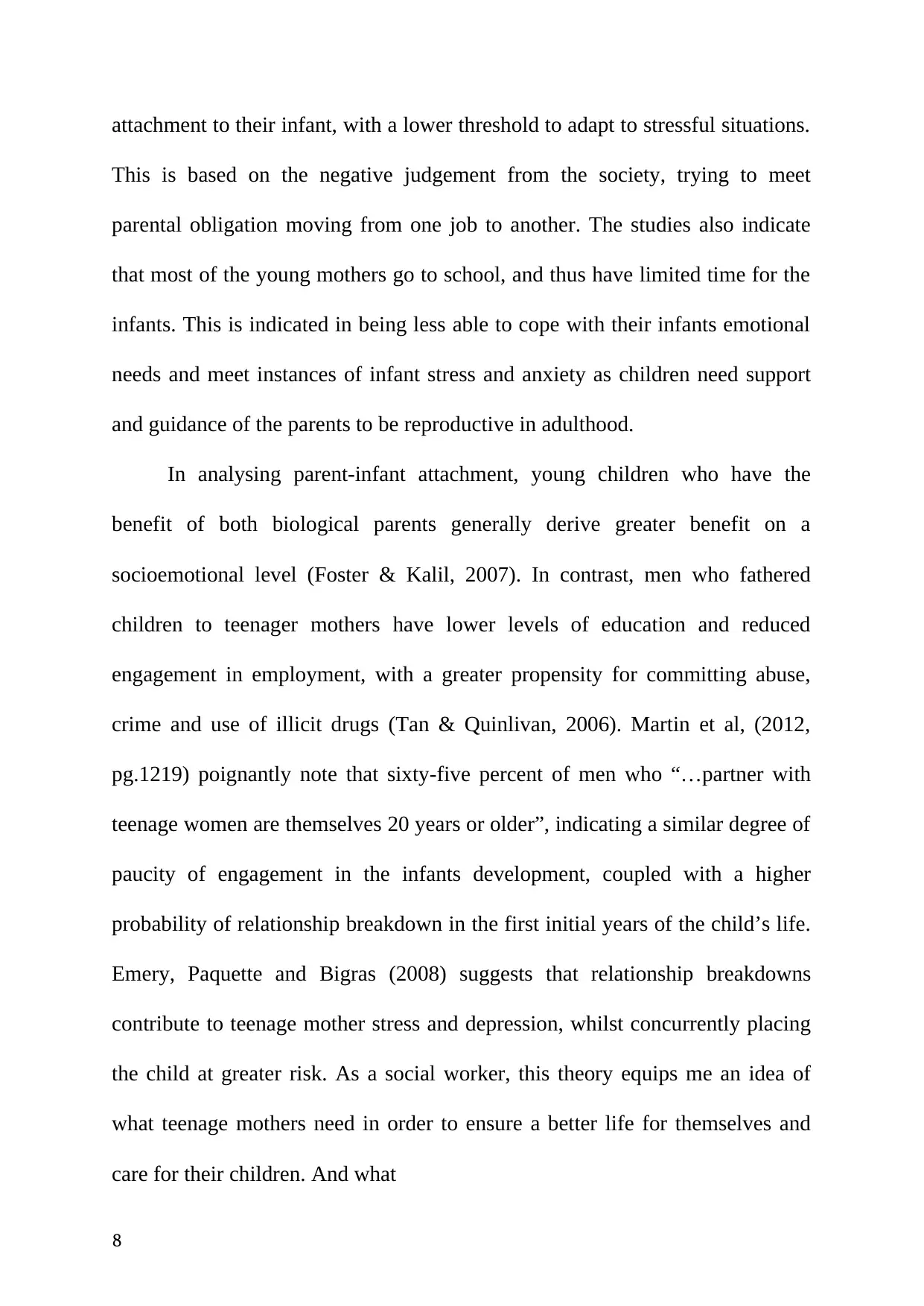
attachment to their infant, with a lower threshold to adapt to stressful situations.
This is based on the negative judgement from the society, trying to meet
parental obligation moving from one job to another. The studies also indicate
that most of the young mothers go to school, and thus have limited time for the
infants. This is indicated in being less able to cope with their infants emotional
needs and meet instances of infant stress and anxiety as children need support
and guidance of the parents to be reproductive in adulthood.
In analysing parent-infant attachment, young children who have the
benefit of both biological parents generally derive greater benefit on a
socioemotional level (Foster & Kalil, 2007). In contrast, men who fathered
children to teenager mothers have lower levels of education and reduced
engagement in employment, with a greater propensity for committing abuse,
crime and use of illicit drugs (Tan & Quinlivan, 2006). Martin et al, (2012,
pg.1219) poignantly note that sixty-five percent of men who “…partner with
teenage women are themselves 20 years or older”, indicating a similar degree of
paucity of engagement in the infants development, coupled with a higher
probability of relationship breakdown in the first initial years of the child’s life.
Emery, Paquette and Bigras (2008) suggests that relationship breakdowns
contribute to teenage mother stress and depression, whilst concurrently placing
the child at greater risk. As a social worker, this theory equips me an idea of
what teenage mothers need in order to ensure a better life for themselves and
care for their children. And what
8
This is based on the negative judgement from the society, trying to meet
parental obligation moving from one job to another. The studies also indicate
that most of the young mothers go to school, and thus have limited time for the
infants. This is indicated in being less able to cope with their infants emotional
needs and meet instances of infant stress and anxiety as children need support
and guidance of the parents to be reproductive in adulthood.
In analysing parent-infant attachment, young children who have the
benefit of both biological parents generally derive greater benefit on a
socioemotional level (Foster & Kalil, 2007). In contrast, men who fathered
children to teenager mothers have lower levels of education and reduced
engagement in employment, with a greater propensity for committing abuse,
crime and use of illicit drugs (Tan & Quinlivan, 2006). Martin et al, (2012,
pg.1219) poignantly note that sixty-five percent of men who “…partner with
teenage women are themselves 20 years or older”, indicating a similar degree of
paucity of engagement in the infants development, coupled with a higher
probability of relationship breakdown in the first initial years of the child’s life.
Emery, Paquette and Bigras (2008) suggests that relationship breakdowns
contribute to teenage mother stress and depression, whilst concurrently placing
the child at greater risk. As a social worker, this theory equips me an idea of
what teenage mothers need in order to ensure a better life for themselves and
care for their children. And what
8

Tjunkaya Ken ID: 110205144 Case Study WELF 3007
Weaknesses of attachment theory are linked to parenting capacity and
what constitutes ‘good enough’ parenting in clinical assessment procedures.
Schmidt, Cuttress, Lang, Lewandowski and Rawana (2007, pg.254) note that
attachment theory represents a critical component in the assessment of a parents
capacity to parent, however this is not generally incorporated into parent fitness
evaluations, nor are “…clearly articulated parenting theories with concomitant
procedures to assess the parent-child relationship”. By example, there are no
empirical guidelines regarding the number or location of observations with a
clinical assessment, with less emphasis put on the parents involvement in past
parenting practices, previous interventions, or a parents desire and ability to
change. Bretherton and Waters (1985) as cited in Peterson (2004, pg.155)
research found a clear correlation between a parents early childrearing
experiences and the quality of their parent’s treatment of them as a child, and
replications of parenting patterns throughout ensuring generations. Further
criticisms of attachment theory is the emergence of a privileged discourse,
which inevitably leads to determinations about what is normative and
acceptable with regard to mothering practices. Inevitable outcomes place value
laden judgments on teenage mothers, rather than empowering them from a
strength-based perspective.
The strength of attachment theory lies in the ability of early intervention
practices for both infant and mother, given their extreme vulnerability. Shaw et
al. (2006, pg.2537) suggests that whilst policies focus on maternal age and the
9
Weaknesses of attachment theory are linked to parenting capacity and
what constitutes ‘good enough’ parenting in clinical assessment procedures.
Schmidt, Cuttress, Lang, Lewandowski and Rawana (2007, pg.254) note that
attachment theory represents a critical component in the assessment of a parents
capacity to parent, however this is not generally incorporated into parent fitness
evaluations, nor are “…clearly articulated parenting theories with concomitant
procedures to assess the parent-child relationship”. By example, there are no
empirical guidelines regarding the number or location of observations with a
clinical assessment, with less emphasis put on the parents involvement in past
parenting practices, previous interventions, or a parents desire and ability to
change. Bretherton and Waters (1985) as cited in Peterson (2004, pg.155)
research found a clear correlation between a parents early childrearing
experiences and the quality of their parent’s treatment of them as a child, and
replications of parenting patterns throughout ensuring generations. Further
criticisms of attachment theory is the emergence of a privileged discourse,
which inevitably leads to determinations about what is normative and
acceptable with regard to mothering practices. Inevitable outcomes place value
laden judgments on teenage mothers, rather than empowering them from a
strength-based perspective.
The strength of attachment theory lies in the ability of early intervention
practices for both infant and mother, given their extreme vulnerability. Shaw et
al. (2006, pg.2537) suggests that whilst policies focus on maternal age and the
9
⊘ This is a preview!⊘
Do you want full access?
Subscribe today to unlock all pages.

Trusted by 1+ million students worldwide
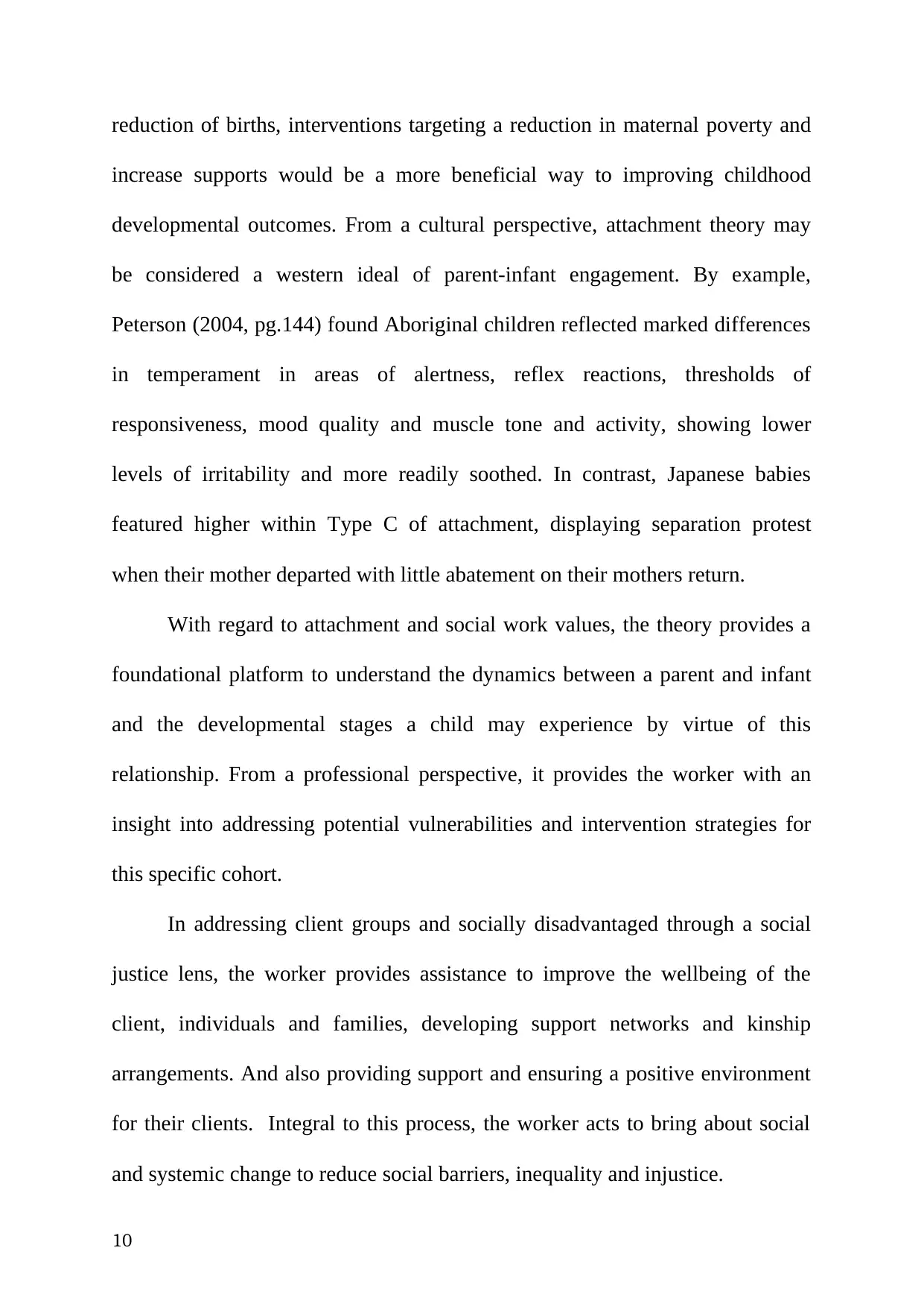
reduction of births, interventions targeting a reduction in maternal poverty and
increase supports would be a more beneficial way to improving childhood
developmental outcomes. From a cultural perspective, attachment theory may
be considered a western ideal of parent-infant engagement. By example,
Peterson (2004, pg.144) found Aboriginal children reflected marked differences
in temperament in areas of alertness, reflex reactions, thresholds of
responsiveness, mood quality and muscle tone and activity, showing lower
levels of irritability and more readily soothed. In contrast, Japanese babies
featured higher within Type C of attachment, displaying separation protest
when their mother departed with little abatement on their mothers return.
With regard to attachment and social work values, the theory provides a
foundational platform to understand the dynamics between a parent and infant
and the developmental stages a child may experience by virtue of this
relationship. From a professional perspective, it provides the worker with an
insight into addressing potential vulnerabilities and intervention strategies for
this specific cohort.
In addressing client groups and socially disadvantaged through a social
justice lens, the worker provides assistance to improve the wellbeing of the
client, individuals and families, developing support networks and kinship
arrangements. And also providing support and ensuring a positive environment
for their clients. Integral to this process, the worker acts to bring about social
and systemic change to reduce social barriers, inequality and injustice.
10
increase supports would be a more beneficial way to improving childhood
developmental outcomes. From a cultural perspective, attachment theory may
be considered a western ideal of parent-infant engagement. By example,
Peterson (2004, pg.144) found Aboriginal children reflected marked differences
in temperament in areas of alertness, reflex reactions, thresholds of
responsiveness, mood quality and muscle tone and activity, showing lower
levels of irritability and more readily soothed. In contrast, Japanese babies
featured higher within Type C of attachment, displaying separation protest
when their mother departed with little abatement on their mothers return.
With regard to attachment and social work values, the theory provides a
foundational platform to understand the dynamics between a parent and infant
and the developmental stages a child may experience by virtue of this
relationship. From a professional perspective, it provides the worker with an
insight into addressing potential vulnerabilities and intervention strategies for
this specific cohort.
In addressing client groups and socially disadvantaged through a social
justice lens, the worker provides assistance to improve the wellbeing of the
client, individuals and families, developing support networks and kinship
arrangements. And also providing support and ensuring a positive environment
for their clients. Integral to this process, the worker acts to bring about social
and systemic change to reduce social barriers, inequality and injustice.
10
Paraphrase This Document
Need a fresh take? Get an instant paraphrase of this document with our AI Paraphraser

Tjunkaya Ken ID: 110205144 Case Study WELF 3007
Anti-oppressive practices with regard to teenage mothers, focuses on an
environment of poor socioeconomic status, education, low levels of
employment, physical and mental health, family instability, racism and
homelessness, notwithstanding negative social discourse labelling these young
women as irresponsible and promiscuous (Weinberg, 2006). In approaching
anti-oppressive practice from an egalitarian value system, advocating for
equality, social justice involves an understanding of the ‘them’, ‘us’ and
‘othering’ that marginalises and disempowers the most vulnerable in the
community, within the hegemonic relations of power (Gray et al., 2012).
In addressing social work values, Weinberg (2006) aptly notes the
contradictory dilemma faced by a social worker when working with a teenage
mother, who is ostensibly a child herself, whilst also responding to the needs of
the infant. Hence, interventions impact on more than one client at a time, with
the potential for conflict. Criticism of anti-oppressive practice is echoed in
Weinberg’s comment (2006, pg.162) when noting that social workers;
“…are caught between an ethic that informs social work as a vehicle of
social justice and a bureaucratic regime in which workers are responsible for
social regulation and the discipline of others”.
Further contradictions to anti-oppressive practice for teenage mothers
emanate from the fear of chid removal, and the subsequent avoidance of support
systems. Kunzel (1993) as cited in Weinberg (2006, pg.165) ironically notes the
historical terminology of ‘illegitimacy’ was fuelled by evangelical social gospel
11
Anti-oppressive practices with regard to teenage mothers, focuses on an
environment of poor socioeconomic status, education, low levels of
employment, physical and mental health, family instability, racism and
homelessness, notwithstanding negative social discourse labelling these young
women as irresponsible and promiscuous (Weinberg, 2006). In approaching
anti-oppressive practice from an egalitarian value system, advocating for
equality, social justice involves an understanding of the ‘them’, ‘us’ and
‘othering’ that marginalises and disempowers the most vulnerable in the
community, within the hegemonic relations of power (Gray et al., 2012).
In addressing social work values, Weinberg (2006) aptly notes the
contradictory dilemma faced by a social worker when working with a teenage
mother, who is ostensibly a child herself, whilst also responding to the needs of
the infant. Hence, interventions impact on more than one client at a time, with
the potential for conflict. Criticism of anti-oppressive practice is echoed in
Weinberg’s comment (2006, pg.162) when noting that social workers;
“…are caught between an ethic that informs social work as a vehicle of
social justice and a bureaucratic regime in which workers are responsible for
social regulation and the discipline of others”.
Further contradictions to anti-oppressive practice for teenage mothers
emanate from the fear of chid removal, and the subsequent avoidance of support
systems. Kunzel (1993) as cited in Weinberg (2006, pg.165) ironically notes the
historical terminology of ‘illegitimacy’ was fuelled by evangelical social gospel
11

women and social workers in a struggle for “…cultural authority and legitimacy
the neophyte profession of social work”. Strengths of anti-oppressive practice
lie in the formation of empowerment strategies, the building of relationships and
advocating for equality and interdependence.
Conclusion
In conclusion, this assignment has analysed two major theories in relation
to the cohort group. The content further reflected on attachment theory and anti-
oppressive practice. Discussion has detailed their strengths and weaknesses
respectively and identified these through social work values. Foundational
strengths of attachment theory are valuable in supporting the developmental
stages of a child, with caution attached to normative values placed on ideals of
mothering (Wade, Cann & Matthews, 2019). Implication of anti-oppressive practice
contributes to teenage mothers and their infants as a particularly vulnerable
cohort of the community who needs help and assistance to be able to lead a
healthy life. Social work values of social justice and equality are supported by
knowledge of theory and skills regarding human behaviour, social structures
and systems.
12
the neophyte profession of social work”. Strengths of anti-oppressive practice
lie in the formation of empowerment strategies, the building of relationships and
advocating for equality and interdependence.
Conclusion
In conclusion, this assignment has analysed two major theories in relation
to the cohort group. The content further reflected on attachment theory and anti-
oppressive practice. Discussion has detailed their strengths and weaknesses
respectively and identified these through social work values. Foundational
strengths of attachment theory are valuable in supporting the developmental
stages of a child, with caution attached to normative values placed on ideals of
mothering (Wade, Cann & Matthews, 2019). Implication of anti-oppressive practice
contributes to teenage mothers and their infants as a particularly vulnerable
cohort of the community who needs help and assistance to be able to lead a
healthy life. Social work values of social justice and equality are supported by
knowledge of theory and skills regarding human behaviour, social structures
and systems.
12
⊘ This is a preview!⊘
Do you want full access?
Subscribe today to unlock all pages.

Trusted by 1+ million students worldwide
1 out of 18
Your All-in-One AI-Powered Toolkit for Academic Success.
+13062052269
info@desklib.com
Available 24*7 on WhatsApp / Email
![[object Object]](/_next/static/media/star-bottom.7253800d.svg)
Unlock your academic potential
Copyright © 2020–2025 A2Z Services. All Rights Reserved. Developed and managed by ZUCOL.


